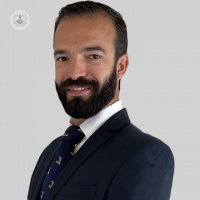Sternoclavicular joint
Mr Majeed Shakokani - Orthopaedic surgery
Created on: 12-04-2018
Updated on: 03-29-2023
Edited by: Conor Dunworth
What is the sternoclavicular joint?
The sternoclavicular (SC) joint is one of four joints that make up the shoulder. The SC joint connects the sternum (breastbone) to the clavicle (collarbone). Injuries to the SC joint are not typically common, and even though they can be very painful, they can heal well without surgery.

What are the symptoms of sternoclavicular joint disorders?
The most common signs of an SC joint disorder occur where the collarbone meets the breastbone. There will be a sharp pain when trying to move the arm if there is a fraction or dislocation. Other symptoms may include swelling or bruising, a grinding sound when moving the arm, limited range of motion and redness over the joint if there is an infection.
What causes sternoclavicular joint disorders?
The most common disorders to occur to the sternoclavicular are caused by injuries or osteoarthritis:
Injuries – these can vary from a mild sprain, which stretches the surrounding ligaments, or a fracture of the collarbone itself. The shoulder joint can dislocate from its normal position in some accidents. Typically, these injuries are caused by a collision, such as in contact sport like rugby, or through a motor vehicle accident.
Osteoarthritis – is where the joints 'wear and tear' with the smooth articular cartilage that covers the SC joint wearing away. It is the most common condition to affect the SC joint and is more likely to occur in those over the age of 50 or in postmenopausal women.
Other conditions – the SC joint may also be affected by rheumatoid arthritis, gout, atraumatic subluxation (where the bone pops out of place without trauma), seronegative spondyloarthropathies or Freidrich’s disease.
What are the different types of shoulder joint dislocations?
Joint dislocation is categorised as either anterior or posterior, which depends on the direction that the collarbone is pushed during injury.
Anterior shoulder dislocation – this is the commonest type of dislocation and is usually caused by a direct blow to, or fall on, an outstretched arm. The end of the collarbone is pushed forward, in front of the breastbone.
Posterior shoulder dislocation – these are far less common than anterior shoulder dislocations and are difficult to identify. It occurs when the ball comes out of the back of the shoulder socket and is usually as a result of indirect trauma. The end of the collarbone is pushed backwards, behind the breastbone and into the upper chest. The injury requires immediate medical attention as vital structures behind the SC joint can be compressed, which can lead to complications with breathing or blood flow.
How are sternoclavicular joint disorders diagnosed?
The specialist will look for swelling, bruising or redness over the joint and will assess the range of movement with the arm. The doctor will check the pulse at the wrist and elbow to see if there is good blood flow circulation to the hands. X-rays or CT scans may be used to confirm the diagnosis and rule out other underlying shoulder conditions.
How are they treated?
Most cases of SC joint disorders are treated without surgery and through the use of medications such as anti-inflammatory drugs. It may be recommended to wear a shoulder sling to restrict arm movement. If there is a joint dislocation, the doctor may try to put the collarbone back into place without making an incision in the skin.
In some cases of posterior dislocation, the doctor may need to make an incision and put the joint back in place with surgery. For those with an infection on the SC joint, an operation may be required to drain it.


